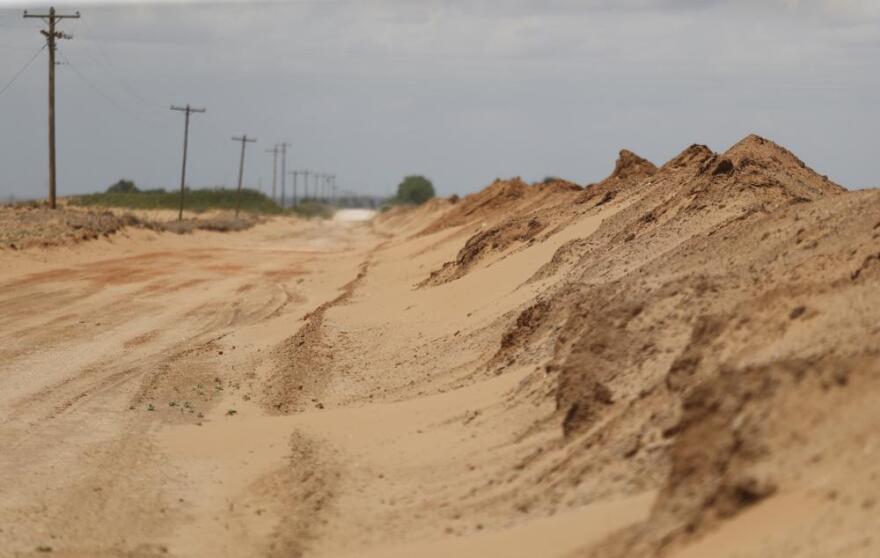For decades, the Texas Panhandle was green with cotton, corn and wheat. Wells drew a thousand gallons a minute from the seemingly bottomless Ogallala aquifer, allowing farmers to thrive despite frequent dry spells and summer heat.
But groundwater that sustained generations is drying up, creating another problem across the Southern plains: Without enough rain or groundwater for crops, soil can blow away — as it did during the Dust Bowl of the 1930s.
“We wasted the hell out of the water,” says Muleshoe, Texas, farmer Tim Black, recalling how farmers irrigated when he was a kid. Water flooded furrows or sprayed in high arcs before farmers adopted more efficient center-pivot systems.
His grandfather could reach water with a post-hole digger. Black is lucky to draw 50 gallons a minute from wells up to 400 feet deep.
Now farmers are facing tough choices, especially in parts of Texas, New Mexico and Oklahoma.
Some are growing less-thirsty crops or improving irrigation. Others, like Black, are replacing some cash crops with cattle and pastureland.
And more are planting native grasses that go dormant during drought, while deep roots hold soil and green with the slightest rain.
“There’s a reason Mother Nature selected those plants to be in those areas,” says Nick Bamert, whose father started a seed company specializing in native grasses 70 years ago. “The natives ... will persist because they’ve seen the coldest winters and the hottest dry summers.”
Black, a former corn farmer, plants native grasses on corners of his fields, as pasture for cattle and between rows of wheat and annual grass.
The transition to cattle, he hopes, will allow his oldest son to stay on the land Black’s grandparents began plowing 100 years ago. His younger son is a data analyst near Dallas.
“You want your kids to come back, but damn, there’s better ways to make a living than what we’re doing,” says Black. “It’s just too hard here with no water.”
Already sand billows off fields during dry spells and clogs fields, ditches and roadways.
Farmers do the best they can, but “everybody knows ... the water’s going away,” says Jude Smith, a biologist who oversees the Muleshoe National Wildlife Refuge, established during the Great Depression and Dust Bowl to preserve native prairie and three spring-fed lakes.
More than half the currently irrigated land in portions of western Texas, eastern New Mexico and the Oklahoma Panhandle could be lost by the end of the century, according to a study last year. And the central part of the aquifer could lose up to 40% of irrigated area by 2100.
Those losses might be slowed as farmers adapt to lower water levels, researchers say. But the projections underscore the need for planning and incentives in vulnerable areas.
The U.S. Department of Agriculture is prioritizing grasslands conservation in a “Dust Bowl Zone” in parts of Colorado, Kansas, New Mexico, Oklahoma and Texas.
But reestablishing native vegetation in the sandy soil over the Ogallala has proven difficult where irrigation ceased on former Kansas farmland. The same is true on land outside the Ogallala previously irrigated with river water, including in Colorado’s Arkansas River Valley.
Extended periods of drought that plagued the Southwest over the past 20 years likely will continue, says meteorologist Brad Rippey with the USDA.
So farmers may need to use some remaining groundwater to reestablish native grasses, says study co-author Meagan Schipanski, an associate professor of soil and crop sciences at Colorado State University.
“In an ideal world, there would be some forethought and incentives available” to farmers, Schipanski says.
Chris Grotegrut, who has planted 75% of his family’s land in native grasses, says most farmers aren’t transitioning fast enough.
“Maybe they’re using the latest and greatest of equipment and technology in the field, but (that) will not totally offset the change that’s coming to them,” says Grotegut, who uses native grasses for grazing and plants wheat directly into native grass pastures.
But experts say federal crop insurance and conservation programs often work at cross purposes: Farmers sometimes plant crops even if they’re likely to fail, because they’re protected by insurance; and cultivating land often is more profitable than government payments for grasslands.
From 2016 through mid-2021, fewer than 328,000 acres (132,737 hectares) were enrolled in the USDA’s Grasslands Conservation Reserve Program in Dust Bowl Zone counties, according to USDA data. Enrollment for 2021 ended last month, but the USDA has not released the most recent totals.
In Texas, fewer than 32,000 acres were enrolled in Dust Bowl counties over the past five years — none in Bailey County, where Black lives.
Although grasslands also can be enrolled in other programs, there was a big push this summer to enroll more in the CRP grasslands program, which allows grazing and was authorized in the 2014 Farm Bill, says Zach Ducheneaux, head of the USDA’s Farm Service Agency.
The agency sharply increased payments to a minimum of $15 per acre, after they were reduced by the Trump administration, Ducheneaux says.
The transition to grasslands and conservation also is hindered by an agricultural banking system that makes it difficult to obtain loans for anything other than conventional farming and equipment.
But farmers need programs that allow them to earn a living while they make the transition to grasslands and less irrigation, over perhaps 15 years, says Amy Kremen of the Ogallala Water Coordinated Agriculture Project.
“There’s a hunger for action that wasn’t there even five years ago,” because of the severity of the water loss, Kremen says. “What’s at stake is the vitality of communities that depend on this water and towns drying up and blowing away.”

